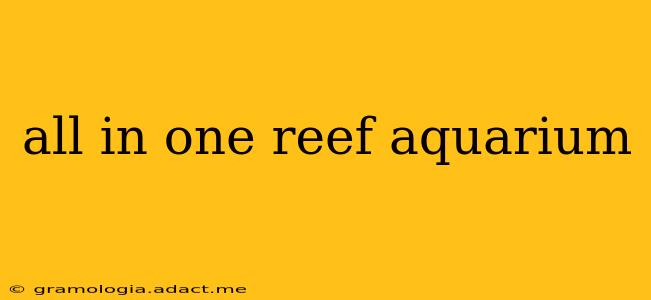The allure of a thriving reef aquarium, teeming with vibrant corals and colorful fish, is undeniable. However, the complexity often associated with marine aquariums can be daunting for newcomers. All-in-One (AIO) reef aquariums offer a fantastic solution, simplifying the setup and maintenance while still delivering the stunning beauty of a mini-ocean. This comprehensive guide delves into everything you need to know about AIO reef tanks, catering to both beginners taking their first plunge and experienced hobbyists looking to streamline their setup.
What is an All-in-One Reef Aquarium?
AIO reef aquariums, also known as integrated reef systems, are designed with all essential components built into a single unit. This typically includes the main tank, filtration system (often incorporating a sump or refugium), and sometimes even lighting and protein skimmer. This integrated design significantly simplifies the setup process and reduces the footprint compared to traditional reef tank setups. The self-contained nature makes them ideal for smaller spaces and those new to reef keeping.
What are the advantages of AIO reef tanks?
Simplified Setup and Maintenance: The integrated design drastically simplifies setup, eliminating the need for separate components and complex plumbing. Maintenance is also streamlined, requiring less time and effort compared to traditional systems.
Space Saving Design: AIO tanks are perfect for apartment living or smaller spaces where a larger, multi-component system isn't feasible. Their compact nature maximizes space utilization without sacrificing aesthetic appeal.
Cost-Effective (Often): While not always the case, many AIO systems are more affordable upfront than assembling a comparable traditional reef tank system from individual components.
Beginner-Friendly: The ease of setup and maintenance makes them perfect for beginners who want to experience the beauty of a reef aquarium without the steep learning curve associated with larger, more complex setups.
What are the disadvantages of AIO reef tanks?
Limited Customization: Customization options are often more limited than with traditional systems, restricting upgrades or modifications.
Potential for Overcrowding: The smaller tank size necessitates careful consideration of stocking levels to avoid overcrowding and maintain water quality.
Upgrading Challenges: Upgrading components like lighting or filtration can be more challenging or expensive than in traditional setups.
Smaller Water Volume: The smaller water volume can lead to more frequent water changes and a greater impact from any issues that arise.
What size AIO reef aquarium should I get?
The ideal size depends on your experience level, available space, and desired stocking. Beginners often start with smaller tanks (10-20 gallons), while experienced hobbyists might opt for larger AIO systems (30-50 gallons or more). Larger tanks offer greater stability and more room for diverse inhabitants.
What equipment do I need for an AIO reef aquarium?
Most AIO systems come with integrated lighting and filtration, but you'll likely need additional equipment such as:
- A reliable testing kit: Regular water testing is crucial for maintaining healthy water parameters.
- Water change supplies: Consistent water changes are essential for maintaining water quality.
- Live rock and sand: These provide beneficial bacteria and create a natural reef environment.
- Proper lighting: Ensure you have adequate lighting for the corals you choose.
- Optional additions: You may consider adding a protein skimmer, heater, or wave maker for enhanced water quality and circulation.
How do I maintain an AIO reef aquarium?
Maintenance involves regular water testing, water changes, cleaning of equipment (like the filter media), and monitoring the health of your corals and fish. Consistent maintenance is key to a thriving reef ecosystem. Frequency will depend on the size of your tank and stocking levels.
How much does an AIO reef aquarium cost?
Costs vary significantly depending on the size, features, and brand. Expect to pay several hundred dollars for a smaller system, with larger, more advanced systems costing considerably more. Remember to factor in ongoing costs for supplies, testing kits, and potential replacements.
Is an AIO reef aquarium right for me?
AIO reef systems offer a convenient and often cost-effective entry point into the captivating world of reef keeping. However, it's crucial to consider your experience level, space limitations, and long-term commitment before making a purchase. Careful research and planning are essential to ensure a successful and enjoyable experience. The simplified setup makes them ideal for beginners, while their efficient design appeals to experienced hobbyists looking for a more streamlined system. Ultimately, the best choice depends on your individual needs and preferences.
